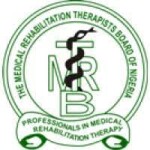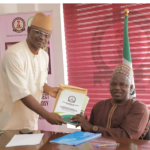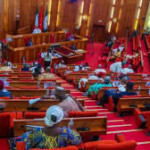Who cares about Nigerians with disabilities dying to access the nation’s battered medical rehabilitation system? Not the government unconcerned about basic health care delivery.
Elijah Olusegun
In 2019, the Federal Road Safety Corps said more than 7000 Nigerian sustained injuries in auto crashes across the nation’s highways. Kaduna, FCT, and Ogun led the way, in that order, in increasing the figure of Nigerians with disabilities. The stat currently stands at 35 million.
On all fronts, the figures have continued to rise, and chillers of debilitating accidents, including occupational ones, mount in the news. No means yet to figure out what much the government is doing to save whatever of physical value the damaged survivors have left. This is not even reckoning with the fate of those born with disabilities which equally require rehabilitation.
Emeka Peter acquired his own disability much earlier in one of the many road crashes that might not even count as a major accident. A motorcyclist ran him over where he stood by the roadside at Ikotun, Lagos, in 2011. “I fell on my back, and discovered I couldn’t feel my legs again,” he told ER sometime in May at the Spinal Cord Injury Association of Nigeria (SCIAN) Centre in Festac. Before this misfortune happened to him, Emeka could feel many things going for him: a thriving spare-part importing business; a fiancé waiting in the wing; and a family of his own on the horizon.
In the confusion that followed the accident, a doctor from a hospital close by ran to the scene. He stopped sympathizers from grabbing Emeka, and hauling him on a bike or in a car. “The doctor put me on a stretcher, and brought me into his hospital for first aid, and then got an ambulance to take me to LUTH,” he said.
After that, the burden to live with and make the best of what is left of his body became his alone to bear. The last hospital he went was the Enugu Teaching Hospital, Nsukka. It is one of the centres the Medical Rehabilitation Therapists Board of Nigeria (MRTBN listed as registered. But from LUTH in the southwest to ESUTH, in the southeast, rehabilitation wasn’t a priority while Emeka underwent treatment.
Alice (not real name) didn’t acquire her own need for rehab. She was born 24 years ago with it—Down Syndrome. Her father and caregiver Babatunde. Willoughby, a learning disability consultant, knows the importance of rehabilitation. There’s little, however, he can do by himself. “Rehabilitation is mostly post-treatment. A follow-up. But there’s nothing like follow-up in Nigeria’s health system,” he told ER. “People with no disability haven’t got access to basic health services—you want to talk about PWDs accessing medical rehabilitation.”
Many things are responsible for making medical rehab an afterthought in disability management in Nigeria. Secretary-General, the Nigeria Society of Physiotherapists, Usman Abba blamed lack of awareness, shortage of personnel, and policy inadequacy. “In developed countries, patients have direct access to physiotherapists,” Abba told ER in a phone interview. In Nigeria, however, as soon as a doctor stabilizes the patients, they are fit to go. All of the polio survivors ER interacted with, for instance, said they never thought they needed rehabilitation, or consulted therapists for opinions at any stage, early or later. “For now, 80 percent of patients pass through doctors before reaching physiotherapists. This is against global practices.” It happens because medical doctors, Abba insisted, are not adequately informed of the need to involve physiotherapists early on. On those occasions when the patients don’t even know they need such help, some doctors, out of concern, may chip in the advice.
A doctor advised Emeka to seek help in India. According to the doctor, that was the only place that could rehabilitate him. But time flies. The effect of delaying or skipping rehabilitation can complicate things after treatment. Abba said quality of life is at stakes. Emeka, now using a walking frame, agreed.
Before he gathered $30,000 to make the medical tourism, Emeka was already writhing in the grip of it. “You know what it means for a man to be unable to have erections or meet a woman?” He began using catheters to empty his bladder, taking drugs to calm his spasm which degenerated to dizziness, and he had to stop. He spent six months in the Indian hospital. Still the outcome of the rehab bothered him: what he expected differed from what he experienced. “And our medical practice here is not so much different from India,” he said. “Apart from the medical equipment they have over there.”
From Emeka’s experience of the best of both worlds, the problem is not lack of medical rehabilitation expertise in Nigeria. Abba said the experts are not enough, though. “The density is very low in Nigeria where we have about 6000 medical rehab practitioners to cover over 200 million people. The MRBTN figure is even way lower. The board says on its website there are 2000 physiotherapists, whom Abba called the cornerstones of medical rehabilitation. Both technicians and occupational therapists, grouped as one, have 86 and 29 respectively. The board registers only 50 speech therapists, four osteopathic therapists, and seven orthotics experts. Conflicting figures from analysts and other sources abound out here, too. But the board didn’t respond to ER’s request for an interview to clarify this. The small figure might just indicate the severity of the problem in private medical rehabilitation practice. Most of these registered experts work in federal and state governments’ tertiary health centres. “A teaching hospital has the capacity to accommodate 650 capacity,” Abba said. As of 2015, Nigeria had a density ratio of 1.7 physiotherapists to 100000 people, when the population stood at 178 million, according to Joseph A. Balogun in a paper for Academic Journals Org. A former president of NSP, Rufai Ahmad, put the ratio at 1 physiotherapist to 85, 000 people in 2017. The last time he checked, Abba said the recommended global density ratio is 1 physiotherapist to 500 people. He believed there was progress. “But you may not find more than 10 physiotherapists in one tertiary hospital in Nigeria.”
Out of the 28 tertiary health centres that offer medical rehabilitation, largely physiotherapy, only 13, including the National Hospital in Abuja, have full MRTBN registration. Thirteen private practices of the total run their centres in Lagos and Abuja, five apiece. Only one of them is accredited in Abuja while all are partially accredited in Lagos. Only one of the government hospitals, state or federal, in Lagos is accredited for medical rehab. Imo has only two, and they are private centres, both unaccredited. Kano, the second most populous states after Lagos, has two government hospitals respectively accredited for medical rehab. Many others are partially accredited for the time being, including the two which the Obafemi Awolowo University Teaching Hospital runs—as academic and clinic. Same applies to the University of Nigeria Teaching hospital whose Enugu centre is partially accredited while the Nnewi, Anambra, centre is fully accredited.
For Willoughby, these lacks of centres and personnel mean irresponsibility. There are places he said the Lagos government designated as rehabilitation centres: one at Owutu, in the Agric area of Ikorodu where PWDs from all over the southwest come for ‘rehab’; and another one at Oshodi. When parents take their children to Oshodi for rehabilitation, he noted, what they get is the centre keeps dosing the kids up with drugs. Especially children with hyperactivity problem. “These children will sleep every time they take the dose daily. After a while, they start growing fat. Some of them have passed on like that,” he said. The only functional centre where he said real physiotherapy is going on is the Modupe Cole Memorial School—thanks to the effort of the son of the late founder. Although the state government has taken over the school, there is nothing to show for it, Willoughby, who chairs the school PTA, said.
Abba saw policy failure in all this. Most people live at the communal level—far away from the urban centres where tertiary health centres and private ones run medical rehabilitation. He said there ought to be a policy that integrates medical rehabilitation into primary health care delivery. Nigeria boasts of 34000 PHCs across its 8806 wards. While such policy, if it is in force, makes access possible, the problem of facility remains. About 80 percent of those PHCs are not functional, according to a recent report of the research the Netherlands commissioned PharmAccess Foundation to carry out. The options available, following the problem of access in places where people need rehabilitation the most, are three: the 28 centres in the urban areas across the nation; quacks; or cheap medical tourism to India.
Emeka returned from his own medical sojourn an unhappy man, after half-a-year rehab. That was what he thought initially. “I didn’t see much improvement when I was undergoing the therapy even over there,” he said. Added to this disappointment was the gradual paralysis of his business until he shuttered it. His source of livelihood thus disappeared. Putting food on the table became difficult. House rent at Festac where he lived then, N750,000 annually, and other domestic bills piled up. He had to relocate to his home state Anambra at some point, and then returned to the SCIAN centre a year later.
The centre is purposed for rehabilitation, and it is accessibility-built: ramps and pavements connecting the few flats and other facilities philanthropists and corporate citizens provided. His choice to move in there largely had to do with his determination to get together whatever was left of his physique. He refused to use a wheelchair, preferring the little body movement his walking frame afforded him. “I don’t just stay in one place. I try to move out to exercise—to avoid pressure sores and depression,” he said. He knew colleagues that pressure sores killed. All his efforts have been yielding since his return from India, slowly though. He no longer uses catheters; his bowels movement and libido have improved, too. “We wedded in 2018, and I had a baby boy last year,” he said.
It appeared Emeka alone among the residents had the motivation to put himself back together, whatever it took. Most of the centre’s 11 residents couldn’t afford a rehab care, either home or abroad. In Nigeria here, a session is N50,000 , he said. And they would have been contented with whatever the Nigerian system could offer if they had got the means.
The centre has always intended to serve as a kind of half-way home—to freely rehabilitate its residents transiting from hospital to their inaccessible environments. It has a rehab clinic which Shell Petroleum Company built and equipped in the 2000s. But staffing and salary payment has prevented it from operating even for just a day. According to Emeka, currently the cluster’s planning and organizing secretary, no help has come from any quarters to make the clinic operational. The Lagos government donated the land for the centre, and built the perimeter fencing about two decades ago. It has not intervened in any form since then.
Which circles back to Willoughby’s take: a government who has not taken care of the basic health needs of its general population cannot care a bit for PWD rehabilitation.
The Lagos Special People Law and the 2018 Discrimination Act have enough policies and provisions that make access to health services a right of PWDs in Nigeria. Whatever the access costs. And policy analysts believe a single-digit- compliance is a good enough starting point. Policy settled, all the government has left to do is shore up the available resources—expertise—to make the access worth it.
The NSP has made efforts to improve the curriculum of medical rehabilitation studies. Abba believed that would not necessarily increase the number of experts or reduce the brain drain plaguing the health sector generally. It will, however, improve the levels of expertise and awareness.
“That will help make rehabilitation experts the first point of contact during treatment,” he said.







